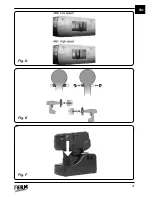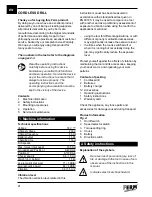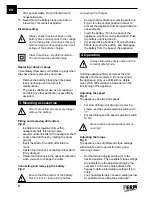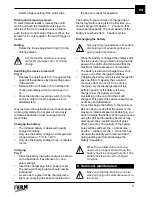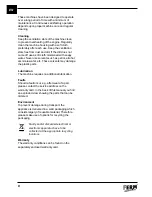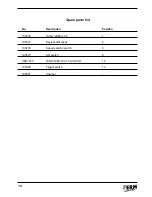
EN
5
The number of revolutions of the
machine can be electronically set.
Do not use in rain.
Indoor use only.
Ni-Cad batteries can be recycled. Drop
them off at a disposal center for
chemical wastes, so that they can be
recycled or disposed of in an eco-
friendly manner.
Always recycle batteries
Hold power tool by insulated gripping
•
surfaces, when performing an operation
where the cutting accessory may contact
hidden wiring or its own cord.
Cutting
accessory contacting a “live” wire may make
exposed metal parts of the power tool “live”
and could give the operator an electric shock.
This appliance is not intended for use by
•
persons (including children) with reduced
physical, sensory or mental capabilities, or
lack of experience and knowledge, unless
they have been given supervision or
instruction concerning use of the appliance by
a person responsible for their safety.
Children should be supervised to ensure that
•
they do not play with the appliance.
Important safety notes on charger and battery
block
If you come in contact with acid from the
battery block, rinse it off with water
immediately. If acid gets into your eyes,
rinse out your eyes at once with water
and contact a doctor immediately!
1. Read and note the operating instructions and
safety notes for the charger and battery block
before use!
2. NB! Only use the charger and battery block
that were supplied by the manufacturer -
otherwise you will risk an accident.
3. Protect the charger, battery block and power
tool from moisture, e.g. rain or snow.
4. Always check that all cables are connected
correctly before using the charger.
5. If you discover that a cable is damaged, you
should not use the charger again. Have the
damaged cable replaced immediately.
6. When the charger is not in use, the mains
plug should be removed from the power
socket. Do not pull out the plug by grasping
the cable.
7. If the charger has been dropped or has
otherwise been exposed to high mechanical
stresses, you should have it checked for
damage by an authorised dealer before using
it again. Damaged parts should be repaired.
8. Exercise caution when handling the battery
block and do not drop it or expose it to
impacts.
9. Never attempt to repair the charger or
battery block yourself. Repairs must always
be carried out by an authorised dealer -
otherwise you risk an accident.
10. Before cleaning or servicing the charger or
battery block, always pull the plug from the
charger socket.
11. Never charge the battery block when the
ambient temperature is below 5 °C or above
40°C.
12. The air vents in the charger must never be
blocked.
13. The battery block must not be short-circuited.
A short-circuit will cause a high current
to flow. This may result in overheating,
the danger of fire or explosion of the
battery block. This may damage the
battery block or the user may risk an
accident.
Therefore:
Do not connect any cables to the poles of
•
the battery block.
Take care that there are no metal objects
•
(nails, paper clips, coins, etc.) on the
contact surface of the battery block.
Do not expose the battery block to water
•
or rain.
Only use the battery block supplied in
•
combination with this cordless drill/
screwdriver so as to avoid faults and/or
risks to persons.
14. A damaged battery block or one that can
no longer be charged must be disposed



